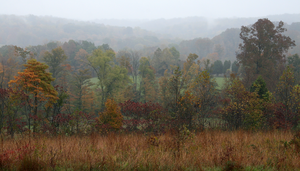Interior Low Plateaus
| Interior Low Plateaus | |
|---|---|

|
|
 |
|
| Ecology | |
| Biome | Temperate broadleaf and mixed forests |
| Borders | |
| Bird species | 203 |
| Mammal species | 69 |
| Geography | |
| Area | 296,000 km2 (114,000 sq mi) |
| Country | United States |
| States | |
| Conservation | |
| Habitat loss | 46.522% |
| Protected | 7.01% |
The Interior Low Plateaus are a physiographic region in eastern United States. It consists of a diverse landscape that extends from north Alabama across central Tennessee and Kentucky into southern Illinois, Indiana, and Ohio. Its natural communities are a matrix of temperate forests, woodlands, and prairies.
This is a region of rolling plains and eroded plateaus, with a temperate continental climate. It is notable for its extensive karst limestone, which comprise the caves at Mammoth Cave National Park. This region includes a portion of what the U.S. Forest service calls the "Central Hardwood Forest".
The underlying bedrock of the Interior Low Plateaus consists of sedimentary rocks such as limestone, sandstone, and shale. These date from the Ordovician period in the Nashville Basin and Bluegrass region, up to the Carboniferous Period in the Shawnee Hills. The Interior Low Plateaus lie at the southern edge of the glacial boundary. Unlike the till plain to the north, the underlying bedrock is generally close to the surface, and the topography of an area depends on how resistant the underlying bedrock is to erosion. More resistant sandstones have resulted in hillier areas such as the Norman Upland and Crawford Upland in Southern Indiana, while softer limestones have already eroded down to gently rolling plains, like the Scottsburg Lowlands and Wabash Lowlands of southeast and southwest Indiana. The hillier parts of the Interior Low Plateaus are not mountain ranges, but dissected plateaus.
The natural communities in this region are a matrix of forest, woodlands, and prairie. Today, much of the open prairie and savanna communities have been lost due to fire suppression and agriculture. However, oak-hickory woodlands remain relatively common, and mesic forest is abundant along riparian areas.
Oak-hickory woodland is the most common natural community in the Interior Low Plateaus. It is the dominant natural community for many areas of rolling hills, including the Western Highland Rim, Shawnee Hills, and Outer Bluegrass. These woodlands represent an intermediate state between a forest and a savanna, with a moderate historical fire frequency. Today, many remnants have transitioned into mesic forest due to fire suppression.
...
Wikipedia
